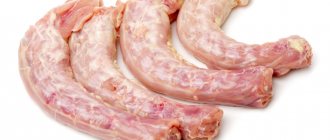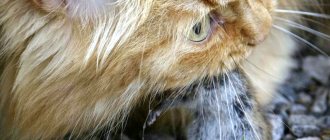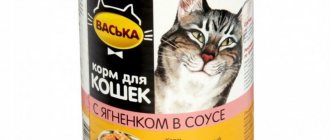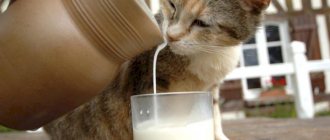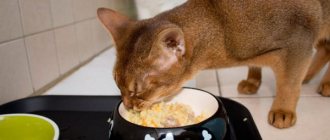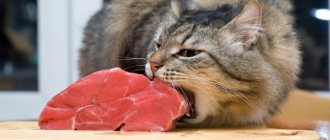Should I cook chicken gizzards for my cat?
Adherents of natural feeding of animals argue among themselves: is it possible to give chicken stomachs to a cat raw or do they need to be boiled first? The first focus on the fact that heat treatment partially destroys vitamins and other beneficial substances. And the latter talk about the danger of infection by parasites and infectious diseases.
However, it should be remembered that any meat sold in a store or on a civilized market must have a veterinary control certificate. This control includes, among other things, checking for parasites. The opinion that since a person does not eat raw meat, he is not at risk of parasites is erroneous, since one can easily become infected through simple contact with meat during the cooking process.
So this issue is under the control of government services, and, in principle, there is no need to be afraid of parasites in meat bought in a store.
It makes no sense to play it safe by freezing meat and offal in the freezer, since parasites are guaranteed to die only at a temperature of minus 28°C for at least 3 days, and in household freezers the maximum temperature reaches minus 18°C.
Therefore, if you have doubts about the quality of offal or your cat does not eat raw meat (there are some), the easiest and most guaranteed reliable way to prepare them is boiling. How long to cook chicken gizzards for a cat? No more than one hour. There is no need to add salt and spices.
Chicken hearts for a cat
There was a problem - the cat only eats boiled chicken (not fillet, I cook it whole for a few minutes and collect all the meat, give it out in portions), does not eat raw meat at all, only boiled chicken, does not eat beef or other meat in any form, only eats poultry, Even fish turns up your nose. Poultry and kefir, sometimes he begs/steals a piece of bread or potatoes. A week ago I was cooking chicken hearts, the cat was all over the place, begging, gave her one raw one, and miraculously ate it. I added raw hearts to the boiled chicken, she eats like a little girl, and with more appetite than usual. When I defrost a portion, I turn it on in the microwave as soon as the aroma comes out. In connection with this, the question arose: how often can you feed your cat chicken hearts? I read that you need to be careful with offal and not all are suitable for daily feeding, but what about hearts?
Best answer
You can, of course, feed them with hearts. You can also offer veal and pork hearts to your cat, just cut off the fat. You can also have chicken stomachs. It’s really better to be careful with liver; it’s better not to give it more than once a week.
Alisa DoroninaArtificial Intelligence (221975) 4 years ago
There is no need to cut off the fat. This is not pork lard. This kind of fat is called visceral fat and animals also need it.
sarda Enlightened (38009) there is too much of it.
Other answers
Usually offal is given 2-3 times a week, perhaps in your case it can be done more often, provided that she eats boiled chicken, which has 0 benefits. You need to be more careful in the sense that some by-products, from the liver, for example, may cause loose stools, if everything is fine with this, let him eat.
Alisa AlekseevaExpert (277) 4 years ago
The stool is normal, every day. So it’s okay if I feed a mixture of hearts and chicken every day? Sometimes I add a little cereal and grated vegetables.
Margarita Tagirova Genius (60575) Of course, it’s okay)
In general, cats naturally eat raw meat, and I think that the liver or heart will only affect its mood.
Heart is a complete protein, much like muscle meat. So come on. It's healthier than boiled. And this is your chance to get your cat accustomed to raw meat. Mix some raw chicken or beef into the chicken hearts, starting with a small piece. Make small portions so that the cat remains a little underfed. Keep this light diet for a week, then you can increase the portion by adding raw meat.
Alisa AlekseevaExpert (277) 4 years ago
With raw meat, I have already given up all hopes, she even smells a small piece of meat in a bowl when ground into the smallest puree and refuses to eat (((so only hearts are used from raw meat, and I am very glad that you can feed them without restrictions))
yes, at least every day. the heart is good muscle meat in principle
You can have chicken hearts, you can have turkey hearts, you can have gizzards. You can’t just give liver, if you give it only once a week. Mix hearts and red muscle meat from thighs and drumsticks to the boiled meat; everything else in the chicken is useless for the cat. If you don't eat all of the meats listed, try red turkey meat and rabbit meat.
Don't give too often
Is it possible to feed a cat chicken stomachs every day? Despite all the usefulness of this product, you should not make it the basis of your diet. According to experts, by-products in a cat’s diet should make up no more than 30%, the remaining 70% being muscle meat. So you should give chicken gizzards no more than twice a week.
When stocking up on provisions, keep in mind that it is recommended to store meat and offal in the freezer for no longer than 3 months, because over time they lose their beneficial properties.
The widespread opinion that you cannot feed a cat both industrial dry food and natural fresh food at the same time has recently been actively refuted by veterinary nutritionists. There is no fundamental difference in the absorption of a dehydrated product and food with a natural moisture content.
The only important question is the individual reaction to one or another component, which can be found in both a dry and natural diet, as well as the balance of the latter in all nutrients.
Can a kitten have chicken stomachs?
Of course you can! Chicken stomachs will be no less useful for a kitten than for an adult animal, because it is an excellent source of protein, potassium, iron, zinc, phosphorus, as well as vitamins B, E and folic acid. Regular consumption of this product makes the diet more diverse in chemical and amino acid composition.
Experts recommend introducing by-products upon reaching two months and giving them once a week. Chicken stomachs can be offered to kittens in finely chopped or ground form. If your baby refuses unusual food, mix it with other foods that he eats more readily.
Elena Shlykova
Recently, the phrase “a cat is an obligate predator” has often been heard. And it is true. Cats are not omnivores. But if you think that a predator needs to be fed meat, then you are deeply mistaken. Eating pure meat leads to serious health problems due to an imbalance of minerals, primarily calcium and phosphorus, and a lack of vitamins. Meat is an excellent source of complete protein, but otherwise it has a poor composition. Therefore, offal for cats is not a delicacy or pampering, but a necessary component of the diet.
The secret to the survival and relative well-being of the wild ancestors of the domestic cat was eating the prey whole. Usually it is a small rodent or bird. In addition to meat, the cat receives bones and cartilage, fatty brain, stomach and intestines with all contents, liver, kidneys, lungs - in other words, all internal organs.
Cats eat whole mice
Feeding offal in addition to muscle meat allows you to balance the cat’s diet without numerous vitamin and mineral supplements. Another advantage is that by using different by-products, you can easily play with the calorie content, reducing or increasing the nutritional value depending on the pet’s needs.
At the same time, you need to carefully feed the internal organs of various animals to your cat, taking some precautions. In the article I will talk about what by-products to give to your pet and in what quantity, so that the benefits from them outweigh the possible negative consequences.
—>
Are you still feeding your pets chemicals? - Then we go to you! (MK on PP for cats)
The backstory of your cat dolls, as well as the history (it’s just the beginning), can be read separately. I will only say one thing - when I took my double happiness home, I already knew: I would feed _these_ correctly and with natural food. I found the recipe on a specialized forum. It is not necessary to follow the exact recipe, the main thing is to observe the approximate proportions and composition of the products “on average” - so that the animal can easily receive from food absolutely all the necessary vitamins and elements for a happy, healthy and long life. Let me remind you right away: cats are predators, “our” food is completely unsuitable for them. So, let's go! The original name is “Kunina porridge”. And today we will have - “Zhopysrukkina porridge”
***this will be a long, but fascinating post***
What we need for cooking: (very)
a large saucepan (as a mixing container), a meat grinder with large holes, a frying pan, a board, a knife, a hammer for beating, a cutting board.
Products. The ideal option for a cat is “bloody” offal, especially heart and liver, as a vital source of taurine. This is the basis. Cats do not need fiber and carbohydrates as such - but they participate in the formation of the necessary flora, and they also add volume to the porridge. I'll tell you about the rest as we go.
What's on the table: veal liver - about 650 g chicken hearts + chicken liver - about 550-600 g each veal heart - half pork heart - 1 piece Each piece of veal and pork lung (last time this place was pork kidneys or spleen) chicken necks without skin - approx. 650 g veal brisket with cartilage - 2 small pieces (last time it was a turkey leg) crucian carp meat - 4 pieces, cleaned and gutted just in case, cut off a large fin (sharp) (last time there was in general, some kind of ungutted small fish like capelin) Ideally, there should be good sea fish: Pumpkin (about a kilogram, I took chopped ones), carrots - 4 large pieces (last time there was also unpeeled zucchini, and less pumpkins) pig ears and nickels - 2 pcs each (ideally, of course you need chicken scallops, but where can you find them) olive oil kelp
We turn on our favorite movie/pederaca/music and start playing. Ideally, it should be cut into small pieces - but it can be done just as well. If you have a combine harvester with a large crusher, it will probably be incomparably easier.
smoking hearts and livers. I alternate products according to “consistency” so that later it will be more convenient to mix
veal heart - without fat. cut it off and throw it away, it’s definitely not good for cats
whole pork - remember about “bloody”! Fresh, it was grunting this morning (I took it at the fair) Taurine - kitten FSIO.
lungs - pork on the right, veal on the left.
crucian carp - purely for “beauty”. There was pangasius and capelin, but we still didn’t have salmon as is, with head and all. It’s a pity, 3 out of 4 were with caviar, but I already threw them out with all the entrails - “out of harm’s way”
We gradually pour everything twisted into one container. I have a hefty saucepan, now the volume is already approaching 3 liters
Chicken necks. A vital thing for cats. 1) calcium from seeds; 2) teeth should work too. And there are no sharp bones in the necks - your pet will not get hurt. For adult cats, and when there is an opportunity, they simply give them the whole neck - let him gnaw. The kids are beaten and cut. My house is small, my little butts with one half-gnawed neck fill up the entire space. Therefore, everything at once is a mess.
We beat back. Beating is actually very easy and quick - the chicken vertebrae crumble well.
And - into the meat grinder. This is what broken necks look like (right)
The brisket is also cut right with the cartilage - and there too.
Ears and nickels are a valuable source of collagen, especially for growing kittens. By the way, in terms of cost per kg, this is perhaps the most expensive part of a kitten’s diet: a pair of ears - 15 UAH, nickels - 10 each (for Russians, 1 dollar = approximately 8 UAH). Cut it smaller
This is what they look like twisted
Calf liver comes last - then the cartilage will better mix with everything else (this is already from practice)
while such a tub is being drawn. But that is not all
By the way, here they are with their assholes - they are watching.
Now it’s the turn of vegetables. I was too lazy to peel the carrots, so I cut off the butts and washed them. There - into the meat grinder.
In the meantime, take a big frying pan and generously pour in olive oil - after all, we’re already making a ton of porridge! There is no need to explain why olive oil is needed, I think. If you don’t have it, then either don’t stew it at all, or do it with water; sunflower oil is not allowed for cats. Ideally, you should drip the oil separately into the finished portion, but I’m too lazy, so let’s simplify the process
throw carrots in there
and start chopping the pumpkin
And - right there in the frying pan
Add a little water - “simmer” - this is literally 5-10 minutes and mix everything properly 2-3 times. Just so that it softens, and the cunning assholes don’t pick out the meat separately and the vegetables separately.
While it's in the frying pan, you have time to finally wipe the blood off the battlefield, put things in order on the table, and get the kelp. It is necessary, cats in this form absorb the iodine they need well. I don’t have sea fish, and there was no powder in the pharmacy either - so we take 1 blister, scoop out the tablets and grind them in a mortar. By the way, you can also take sushi sheets - they also work well. I forgot to take a photo of this right away - there is no mortar, there is a cup and a potato masher. Voila!
By the way, in this place - cutting grass - I also tried out a new ceramic knife. Well. Don't know. It's good that I didn't buy the set right away.
Pour everything into the same pan, gracefully distribute the crushed kelp on top
And then the vegetables arrived. I poured everything into one pile and wondered how to mix it now. "
. and realized that this time I need to take a basin
I even weighed it - it came out to 6.5 kg. The total cost is approximately 100 UAH, maybe a little more. This is without the cost of oil and tablets. Absolutely balanced, healthy food. Now all that remains is to pack this thing into cups. Also sorry, I forgot to take a photo right at the beginning
There are about three of these spoons for each glass. Last time I put in 2 spoons, but the girls are growing up, lately they haven’t even had enough 2 cups a day, they needed three.
Freezing is a must!! The fact is that during subsequent defrosting, the protozoa (if any) burst. Profit.
I fill the defrosted portion with yogurt without sweet additives. This time there was activity. I don’t take it often - because it manages to turn sour before the asshole’s hand “finishes” it. I usually take something smaller. Yogurt or kefir is needed, firstly, as a source of fermented milk, and secondly, the “porridge” under the yogurt does not get soggy, and cats are happy to lick the bowl clean. But mine categorically refused kefir, so - yogurt.
We survey the “battlefield”
And we put the food in the freezer
I spent an hour and a half on everything without straining myself, listening to the wonderful “X-Factor”, watching yesterday’s live broadcast on the Internet. This will last us about 3 weeks. I also give them hard cheese (rarely, speckled), I can smear butter on their noses, once a week I give them an egg, 10% cream is freely available. Sometimes they wake up. I don’t know what wakes them up - but they ask for sweets; the son is happy to share a cake or pancakes
My cat dolls are now 4.5 months old. The bead weighs 2600, the Matryoshka 2400. They are satisfied and happy, and love me almost as much as I love them. And I just LOVE them!
PS The main advantage of such a “porridge” was revealed quite unexpectedly. They hardly drink water (the moisture they get from meat is enough for them) and - most importantly. - they have no smell
toilet. At all . I had the opportunity to compare. Those. At first I didn’t pay attention - well, it’s nice, since it doesn’t stink, then what should I think about it? And then the porridge in the freezer ran out, and there was so much work to do, there was really no time to run around the store-bazaar, buy ingredients and stand around twisting and packaging - I ran out and bought Royal Canin for the kittens. MOTHER, at first I didn’t even understand why such a smell came from the pot. (lost the habit) And then it came.
Substitute Products
You can treat your pet to boiled fish, but not often.
Veterinarians say that it is better for the cat to eat other foods that contain no less useful components instead of a chicken bone. You can replace bone mince with the following dishes:
- Fish. When a cat eats such a product, you should also carefully monitor it so that it does not choke on the bone. It is strictly forbidden to replace the main food with it; fish should only serve as an additive. It is allowed to feed your pet this dish 1-2 times a week, but it is allowed only in boiled form.
- Special bones. They consist of tendons and movable joints in crushed form, as well as beef stomachs.
It is best to give preference to specialized dry food for cats, which must be given to the animal in a certain dosage. This food is as balanced as possible, since it contains all the beneficial microelements in the quantities necessary for the cat’s body. When purchasing a product, the age and health of the pet are taken into account. It is equally important to read the composition of the product, because if it contains flavorings, preservatives and salt, then you should not choose such dry food. It is important for the owner to understand that only premium and super-premium products will be useful. If your cat still wants to eat chicken bones, then you should give them with leftover meat and cartilage. In this case, the pet will satisfy its hunting urges and will not cause harm to the body.
Why can't a cat eat bones?
Sometimes fragments of such food can get stuck between the animal's teeth.
If a cat ate chicken paws or other bones once, then perhaps nothing bad will happen, but when an animal constantly eats broken chicken bones, serious health problems are possible. The seed does not have any nutritional value, but contains many useful microelements. This is the only benefit to feeding your cat chicken bones. In most cases, such a component in a cat’s diet can have dangerous consequences, even if the bones are boiled or made into bone mince. Such a diet threatens the following disorders:
- mechanical damage to the mucous membrane of the mouth, esophagus, stomach or intestines;
- hard pieces getting stuck between the teeth, which leads to gum injury;
- blockage of the digestive tract.
Tubular bones and chicken feet pose a particular danger to a cat's health. This is due to the fact that such parts have sharp edges that severely injure the mucous membrane. Spongy components are less dangerous, but can still provoke an inflammatory reaction or blockage of the esophagus. In the latter case, the cat exhibits the following unpleasant symptoms:
- constipation or diarrhea with blood in the stool;
- lethargic state;
- problems with appetite;
- repeated vomiting;
- copious amounts of saliva;
- pain during bowel movements.
How often to give your cat by-products, and in what quantity?
The share of by-products in the diet is calculated depending on their type. Muscular organs - the tongue, heart, gizzard of the bird - are given as part of the “meat” part of the diet, the total share of which is about 70%.
Internal organs (liver, kidneys, lungs, brains, spleen) provide 10-15% of the total diet. Another 10% should come from bones. Their sources are rabbit or poultry ribs, chicken necks and heads, and quail frames. The share of meat and bone ingredients is about 20%.
Chicken neck for a cat
If the cat has not eaten offal before, it needs to be introduced to it gradually, starting with microscopic quantities. When switching from dry food to natural food, the cat is first fed muscle meat, and then they begin to give various by-products, monitoring the pet’s individual reaction.
A variety of by-products is good for your pet
Muscle by-products can be fed to your cat daily, and some are fed 1-3 times a week to add variety to the diet. If, in response to feeding the internal organs, the cat's stool becomes thinner, their quantity is sharply reduced and the digestive tract begins to re-acclimate, gradually increasing the volume to the desired level.
Next, we will take a closer look at some types of by-products and their optimal quantity.
What is healthier to give to a cat? Chicken stomachs or hearts?
Both are good if you give it 2-3 times a week, and not feed it constantly. Give the stomachs whole and straight with the yellow film - it is useful for the digestion of cats. Good nature - homemade minced meat (beef, chicken, etc.), 3/5 of the mixture is minced meat, 1/5 is boiled cereal (rice, buckwheat, maybe a little raw oatmeal), 1/5 is grated carrots or zucchini. You can add eggs, liver, and other offal. Freeze in portions too. If the minced meat was beef and without eggs, you can serve it raw, just defrost it. Boil the rest. Sometimes you can give a piece of raw beef, gov. heart. You can turn fresh chicken necks in a meat grinder (turn easily, preferably 2 times) (freeze the minced meat in portions on a board covered with plastic in the freezer and serve occasionally. No more than 3 times a week. Otherwise there will be constipation. This can be raw. 2 times a week week - egg, boiled fish without bones, boiled liver). You can sometimes (rarely) soak and boil the kidneys. Kefir, occasionally fermented baked milk, sometimes a little milk (it actually weakens adult cats), cottage cheese. Sometimes vitamins (preferably containing TAURINE) You cannot alternate between dry and natural.
Other answers
He eats both very well. Fine! These are not bones, these are bones - very good. harmful!
my friend feeds hearts to the cat - the doctor told them
This is not cat food. He will get sick and die. Sometimes, but not all the time.
anything. Only special canned food for cats is harmful - they kill them slowly. But mixed canned food with cereals is still tolerable
KalettaEnlightened (38418) 11 years ago
In your opinion, it turns out that the entire civilized world purposefully feeds its pets poison, and scientific institutes specifically develop poison recipes. And the idea about porridge for predators is generally unknown where it came from. The horse is not fed meat, and the predator does not need porridge.
Antonia-Juanita Master (1170) civilized, not civilized, have you ever wondered what I make this product from - good meat from bull, turkey and rabbit? Or maybe soy? Or what else?
TashaArtificial Intelligence (111615) 11 years ago
Very good! This means that soy with meat and bone powder kills cats (this is true, by the way, but you somehow didn’t take into account that many people buy expensive canned food, not whiskey, but Royal or Hills) - but soy mixed with porridge is better?!
Antonia-Juanita Master (1170) just how to feed pure soy is one thing, but soy with porridge is better in any way. Sawdust is not digestible, but porridge will at least be of use
Chicken heart in the diet of cats
This is one of the most delicious and nutritious offal. Chicken heart for cats is a source of protein, the content of which in 100 grams of the product is 15.8 g. Moreover, they contain 10 g of fat and only 0.8 carbohydrates.
It contains a huge amount of taurine, which is so necessary for domestic carnivores for a happy life. It helps digest food in the small intestine. The body of felines is designed in such a way that it cannot reproduce taurine in sufficient quantities on its own. Therefore, products containing animal protein are vital for cats. Taurine is not found in plant-derived ingredients. Its deficiency has a bad effect on:
- vision;
- cardiac activity;
- ability to reproduce;
- integrity of nervous tissue;
- growth in kittens. Externally, this manifests itself in spinal deformation and even in the development of defects in the immune system.
Can a cat have chicken hearts? Of course, unless he is allergic to chicken. But this dish in any form should not be considered the basis of nutrition. As with other by-products, do not feed them too often. This inevitably leads to diarrhea. It is necessary to add a variety of foods to the diet to satisfy the needs of the domestic carnivore.
By-products for cats are the only source of calcium
The most common mistake in natural feeding of cats is a violation of the ratio of calcium and phosphorus in food. For adult animals, the Ca:P balance should be approximately 1.2-1.7:1, for kittens 2:1. At the same time, most products, including meat, contain much more phosphorus than calcium.
The only chance to enrich the natural diet with calcium is to feed your pet not only meat, but also bones. To do this, chicken necks and heads are introduced into the diet.
Chicken heads: Cat's dinner can look creepy
Depending on the size and habits of the cat, chicken necks give:
- Entirely;
- Cut into pieces;
- Scrolled through a meat grinder as part of a meat mix.
Whole, sliced and twisted chicken necks
The hard and sharp beak is cut off from the chicken heads, and the heads themselves can first be beaten with a hammer.
Rules for feeding cats with bone by-products:
- Bones are given ONLY IN RAW FORM. Boiled bones are dangerous for cats.
- Bones should make up about 10% of the diet, which means 20-30% meat and bone ingredients.
- If the cat's feces become dry, white, or bowel movements are irregular (constipation), bones are excluded from the diet or their quantity is reduced.
- They only give spongy bones, not tubular bones (legs and wings are not allowed).
If you are afraid to give your cat bones or she cannot eat them for health reasons (diseases of the gastrointestinal tract, lack of teeth, etc.), calcium should be added to the diet in the form of commercial veterinary supplements.
About the benefits of chicken meat
It's no secret that chicken meat is considered dietary. It is easily absorbed by the body, so even people weakened after surgery are recommended to first eat nutritious chicken broth, then add white chicken breast meat to the diet.
The big advantage is that chicken meat is inexpensive and cooks quickly. The product contains a large amount of easily digestible protein, and the tender consistency of the meat is liked not only by people, but also by pets. It is provided by a minimal amount of connective tissue. The digestibility of chicken meat is 90%.
Chicken has two types of meat: white and red. Chicken breast meat is commonly called white. It contains less fat and more protein, and is considered dietary because it is low in calories (about 110 kcal per 100 g of product). But veterinarians do not recommend feeding your cat only white meat. Yes, it contains more magnesium, but red contains no less important microelements - iron and zinc, as well as vitamins.
Chicken meat contains vitamins necessary for any living organism, including A, group B (B1, B2, B4, B5, B6, B9 and B12), C, D, E, K, PP. In addition, chicken contains:
- calcium;
- magnesium;
- phosphorus;
- potassium;
- sodium;
- iron and other trace elements.
The rich composition of nutrients allows veterinarians to recommend feeding domestic cats chicken meat - not only the breast, but also other parts of the carcass. However, it is strictly forbidden to give skins and long bones to your cat. Leather is poorly digested in the stomach of pets; moreover, it contains a lot of fat and, if eaten regularly, even in the healthiest cats, will eventually cause problems with the liver, pancreas, and gall bladder. When chewed, tubular bones break into sharp fragments. They can injure the intestines, so they are prohibited for cats.
By-products to increase calorie intake
Some parts of the carcass contain woefully little protein but are high in fat. And some, such as testes, are a source of protein and fat at the same time. Fatty by-products should not be given to cats with impaired liver or pancreas function, as well as animals prone to obesity. But they serve as an excellent energy boost, for example, for nursing cats or stud cats.
Testes (bovine, lamb)
Although the seeds are considered a delicacy in many cuisines around the world, they are quite difficult to find for sale. They don’t have to be included in your cat’s diet for it to be complete, but if the opportunity arises, be sure to let your pet try them.
Beef testes
The testes contain a lot of protein and fat, B vitamins and microelements (zinc, manganese, copper, nickel).
There is no need to be afraid of the hormones supposedly contained in the testicles. Their concentration in the testes is negligible, since all produced testosterone immediately enters the blood.
The testes are given raw or lightly boiled (7 minutes after boiling). Before giving them to a cat, remove the thick shell from the testicles and cut them into pieces. The norm is 5-10% of the diet, while it is permissible to feed the testes in a separate feeding, without mixing them with meat.
Beef udder
Udder is a cheap and nutritious product, but I recommend feeding it to cats with caution. The dry udder consists mainly of fat and rough connective tissue, which is difficult to digest. The milk udder has a more delicate consistency and a pleasant sweetish milky smell and taste. But cows are rarely slaughtered for meat during lactation without a good reason; usually these are sick animals. Therefore, the milk udder must be carefully checked for signs of mastitis (pus, inflamed areas).
The udder contains about 12% incomplete protein and 14% fat. It is given to cats in order to increase the calorie content of the diet, in an amount of no more than 5% of the total diet. This product is fed both raw and cooked (the broth after cooking is not used for feeding). The udder has a rubbery consistency, it is very difficult to chew or bite off a piece, so you need to cut it into convenient pieces in advance. The easiest way to cut a frozen product is to use a very sharp knife.
Brain
Beef brains can be difficult to find commercially because they are perishable. But if you give your cat chicken heads, then when she eats them, she also gets brains. The value of brains lies in the fats they contain. These are omega fatty acids, lecithins and cholesterol. The brain also contains a lot of choline (B4).
Beef brains, if you were able to buy them, are not fed in their pure form, but are added to the meat mixture. The high fat content of this offal causes severe diarrhea in cats if the dosage is overdone. Brains are given in the amount of 2% of the total diet. They can be especially useful for cats exhausted by pregnancy and lactation, as they increase the calorie content of food.
Lungs - is it worth giving them to a cat?
One of the most useless beef by-products is lung. It is made of connective tissue and is difficult for cats to digest. In many animals, eating “airy” offal causes vomiting. Therefore, it is given in small quantities and in combination with meat or other organs.
Beef lung
It is quite possible to create a complete diet without using lungs, but if the cat likes their taste, they are fed in a volume of 5-15% of the diet. The peculiarity of this by-product is its low calorie content, which can be useful when preparing a diet for overweight animals.
If you cut the lung into small pieces and dry it in the oven, you will get an excellent delicacy. It is given to cats between main feedings.
How to make hearts for cats
So, let's talk about the components of a healthy diet:
WHAT IS NECESSARY
The optimal set of foods for a cat’s diet includes beef, chicken and their by-products (heart, kidneys, stomachs, lungs, liver); fermented milk products (low-fat kefir, cottage cheese). In combination with meat products, rice, buckwheat, and rolled oats are very useful. It is also worth adding vegetable oil and some vegetables (carrots, zucchini, cabbage leaves). Vegetables and cereals should make up approximately 10% of the daily diet.
Basic rules for healthy cat nutrition
- About 90% of the diet should consist of meat and offal.
- Cat dishes are served raw (with the exception of some products, which will be discussed separately) and at room temperature. It is advisable to defrost frozen portions at room temperature.
- After preparing raw meat portions, place them in the freezer for at least three days. Freezing kills almost all dangerous bacteria and parasites.
- Buy meat only from a trusted place.
- Food should contain bones or calcium supplements.
- Most of the diet should be offered in the form of pieces, since the pet must work with its jaws, tear and chew food. This is important for the cat’s health and prevents problems with teeth and gums.
- Clean water should be freely available.
- It is necessary to follow the feeding regimen and not exceed the portion size. An adult animal is fed twice a day, in the morning and late in the evening. The daily norm for a domestic, sedentary pet is approximately 50 g/kg of weight.
A cat's menu is much poorer than a human's. Cats are absolute predators; under natural conditions, very few grains and barely noticeable amounts of vegetables enter their stomachs. Therefore, no matter how healthy porridge, raw and baked vegetables may be for humans, they should not be included in your pet’s diet. We advise you to read the article, which describes in detail foods that are harmful to your cat’s health.
One of the easiest to prepare dishes that are most similar to natural food are raw chicken heads and necks. Some people do not believe and are even horrified that their cute cat is able to greedily bite into a chicken head and not choke on the bones. But it is the bones of the heads and necks that the cat will gnaw without harm to health. Moreover, such nutrition will bring a lot of benefits to the animal. Heads and necks require treatment before feeding, but this is not difficult to do.
How to Prepare Chicken Heads
Most often, such products are sold in frozen packages. Wait for the heads to thaw. Then you need to rinse them with cool water, cut off the beaks (they are too tough for a cat), and cut them in half lengthwise. This will not require noticeable physical effort.
If the head is small and the pet is large, you don’t have to cut it - more nutrients will be retained in the product. Then the halves are put into portioned boxes or cups. You can use plastic cups with a volume of 200 ml, the same volume as sour cream and mayonnaise boxes. One such serving will last a medium-sized adult domestic cat for the whole day.
Chicken hearts: recipes for preparing delicious dishes
The simplest thing is to simmer with onions and carrots. Or boil and then brown in oil. Sometimes they are fried first and then finished in a creamy sauce.
Hearts are one of the most profitable and convenient products to cook. They have almost no waste, they are nutritious and healthy. They are also very tasty and soft if cooked correctly. I offer several options that never cease to please.
Chicken heart salad “Heartbreaker”
This is a simple option for an everyday menu. It can also be placed on a festive table if you decorate it with finely chopped yolk or grated whites mixed with pomegranate seeds.
For 2 servings you will need:
If you are not on a diet, use mayonnaise. It tastes much better with it

